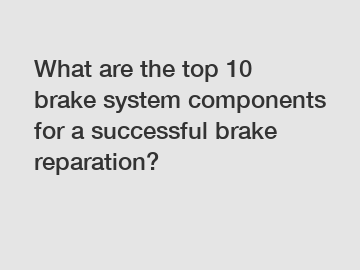What are the top 10 brake system components for a successful brake reparation?
The braking system is one of the most crucial components of any vehicle, as it ensures the safety of both the driver and all passengers. To guarantee a successful brake reparation, it is necessary to understand the top 10 brake system components and their roles. In this article, we will delve into each component and explain how their proper functioning contributes to effective brake repairs.
1. Brake Pads:
The brake pads are perhaps the most critical component of the braking system. They are responsible for creating friction against the rotors, allowing the vehicle to slow down or come to a complete stop. Quality brake pads ensure optimal performance and should be inspected regularly for wear.

2. Brake Rotors:
Brake rotors are the metal discs that the brake pads clamp onto. They play a significant role in stopping the vehicle by absorbing the heat generated during braking. Like brake pads, they should be inspected regularly for any signs of wear or damage.
3. Brake Calipers:
The brake calipers hold the brake pads in place and apply pressure to the rotors when the brakes are engaged. It is essential to inspect the calipers for any leaks, damage, or signs of sticking, as these issues can affect brake performance and safety.
4. Brake Lines:
Brake lines are responsible for transmitting hydraulic pressure from the brake pedal to the calipers. Any leaks or damage in the lines can result in a loss of braking power. Regular inspection of brake lines is crucial to detect any potential issues before they become significant problems.
5. Brake Fluid:
Brake fluid is a hydraulic fluid that transfers the force from the brake pedal to the brake calipers. It must be clean and free from moisture or air bubbles for a responsive braking system. Regular brake fluid flushes and replacements are necessary to maintain optimal performance.
6. Brake Master Cylinder:
The brake master cylinder is the heart of the brake system. It converts the pressure applied to the brake pedal into hydraulic pressure, which is then transmitted to the calipers. Any malfunction in the master cylinder can severely impact brake performance and should be addressed immediately.
7. Brake Booster:
The brake booster assists in reducing the amount of force required to engage the brakes. It amplifies the pressure exerted on the brake pedal, providing a smoother and quicker response. A faulty brake booster can make braking cumbersome and should be inspected if any issues are experienced.
8. Brake Fluid Reservoir:
The brake fluid reservoir stores the brake fluid, ensuring a constant supply for the brake system. It is essential to check the reservoir regularly and keep it at the recommended level to prevent air from entering the system, which can lead to brake failure.
9. Brake Drum:
Brake drums are usually found in the rear wheels of older vehicles. They are responsible for slowing down or stopping the vehicle by creating friction with the brake shoes. Proper inspection and maintenance of brake drums are essential for their smooth operation.
10. Anti-lock Braking System (ABS):
The ABS is a safety feature that prevents wheel lock-up during emergency braking situations, improving vehicle control. It consists of sensors, control module, and hydraulic valves. Ensuring the proper functioning of the ABS is vital for safe driving.
In conclusion, a successful brake reparation requires attention to each of the top 10 brake system components. Brake pads, rotors, calipers, lines, fluid, master cylinder, booster, reservoir, drum, and ABS all play crucial roles in the overall performance and safety of the braking system. Regular inspection, maintenance, and prompt repair or replacement of any faulty components are essential for ensuring the efficiency of brake repairs. If you have any concerns or require professional assistance, do not hesitate to contact us.
Want more information on Ceramic Brake Pad Price in China, Semi-Metallic Brake Shoes Manufacturer, D1357 Auto Brake Pads? Feel free to contact us.


